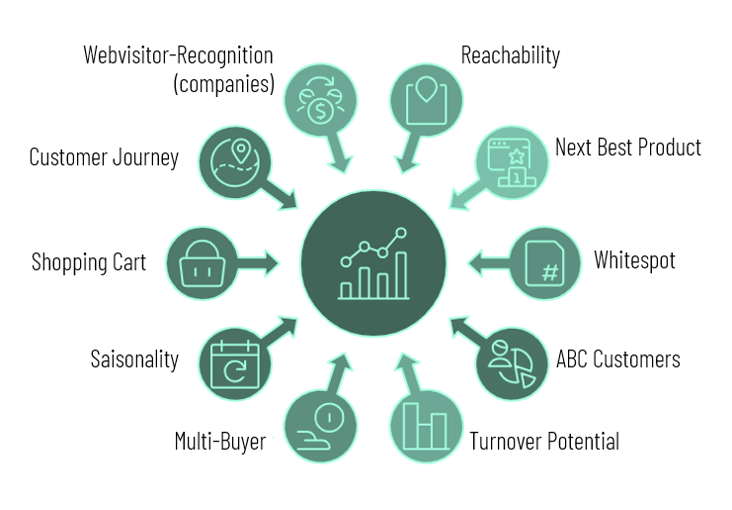TARGET GROUP ANALYSES & KI
Understanding data, recognizing opportunities.
Data has its own language. With the right methods and systems, you can not only read them, but also interpret them. It’s part of our job – for over 75 years.
You finally want to get more out of your data? You want to find the needle in the haystack? Schober’s analysis team welcomes any challenge.
Be inspired by the variety of analytical possibilities at Schober.
Which of the following objectives would you like to shed analytical light on? Please choose your topic:
WHAT DO WE WANT?
- Generate knowledge about your own customers.
- Find out differences between customer groups.
- Gain insights into how to address target audiences.
HOW DO WE DO IT?
For profiling, your customer data is enriched with all available characteristics from the Schober data universe. This creates a 360° view of the existing customer segments. This involves comparing both customer groups (e.g. differentiated according to acquisition channels, activity level or product use) with each other and with the cross-section of the population / company landscape. Marketing and sales-relevant differences become clearly visible.
WHY SCHOBER?
We have the external qualification characteristics necessary for such a task – both for B2C (private customers) and B2B (corporate customers).
WHAT DO WE WANT?
Promote the right target group with the right product via the right channel.
HOW DO WE DO IT?
In customer structure analysis for new customer acquisition, the first step is to determine the customer profile (e.g., for profitable existing customers; new customers in the last 12 months; customers who have purchased a specific product or customers generated via a specific channel). Subsequently, an analysis model (scoring) is developed individually for your task. With the help of this model, we can identify new customer potentials with the same profile in the Schober data universe – across all available communication channels.
WHY SCHOBER?
We have both the external qualification characteristics and the new customer potential needed for such a task.
WHAT DO WE WANT?
- Get information on the market penetration of their own products.
- Perform data-based sales territory and location planning.
HOW DO WE DO IT?
The customer data is compared with the Schober data universe and the hits are marked. Subsequently, the hits in the unit to be analyzed (postal codes, industries, sales territories, locations) are compared with the total potential available in the respective unit. The result can then be displayed cartographically.
WHY SCHOBER?
With the help of Schober’s own household and company databases (data universe), the total market can be defined and thus the market coverage, or market potential, can be determined.
WHAT DO WE WANT?
- Generate knowledge about your own customers.
- Find out differences between customer groups.
- Gain insights into how to address target audiences.
HOW DO WE DO IT?
For profiling, your customer data is enriched with all available characteristics from the Schober data universe. This creates a 360° view of the existing customer segments. This involves comparing both customer groups (e.g. differentiated according to acquisition channels, activity level or product use) with each other and with the cross-section of the population / company landscape. Marketing and sales-relevant differences become clearly visible.
WHY SCHOBER?
We have the external qualification characteristics necessary for such a task – both for B2C (private customers) and B2B (corporate customers).
WHAT DO WE WANT?
Promote the right target group with the right product via the right channel.
HOW DO WE DO IT?
In customer structure analysis for new customer acquisition, the first step is to determine the customer profile (e.g., for profitable existing customers; new customers in the last 12 months; customers who have purchased a specific product or customers generated via a specific channel). Subsequently, an analysis model (scoring) is developed individually for your task. With the help of this model, we can identify new customer potentials with the same profile in the Schober data universe – across all available communication channels.
WHY SCHOBER?
We have both the external qualification characteristics and the new customer potential needed for such a task.
WHAT DO WE WANT?
Separation of the customer base into homogeneous segments, which have a different value and should therefore be serviced in a differentiated manner.
HOW DO WE DO IT?
Based on the customer’s own characteristics (sales, transactions, master data, communication data,…), classification methods (e.g. cluster analyses) are used to determine customer clusters that are homogeneous and heterogeneous among themselves. Care is taken to ensure that the dimensions of value, loyalty and communication are included. The clusters thus identified are then described using external characteristics (e.g., sociodemographics, living environment, interests, and travel or leisure behavior). Based on these results, marketing and sales activities can be managed in a more target group-oriented manner.
WHY SCHOBER?
In addition to great expertise in building such customer segmentations, we have the right external data to describe the segments.
WHAT DO WE WANT?
Determination of an individual customer value that takes into account both the current value of the previous customer relationship and the development potential.
HOW DO WE DO IT?
Based on the customer’s own characteristics (e.g., sales, transactions, master data, communication data) and suitable third-party data (e.g., social class, purchasing power, residential situation, shopping behavior), a score is generated either rule-based or using statistical methods. In addition to the current customer value, the perspective development opportunity is also included. The result: customers can be selectively served according to their economic potential (e.g., frequent or less frequent advertising stimuli, differentiated offers according to price, or special customer loyalty programs).
WHY SCHOBER?
Even if only a few own characteristics are available (e.g. for prospective customers), a customer value can be calculated with the help of the Schober data universe.
WHAT DO WE WANT?
- Which customers can be offered a higher-quality product instead of the low-priced variant?
- Which customers are suitable for additional sales?
HOW DO WE DO IT?
Multivariate statistical methods, information from the customer databases (sales, transactions, master data, communication data,…) and the integration of additional data from the Schober databases enable the identification of those customers who promise additional sales potential through cross- and up-selling. This involves building scores from information in historical data and applying them to the current inventory to forecast future customer behavior.
WHY SCHOBER?
In our data universe, we have the right external data (e.g. purchasing power, social class, turnover classes, number of employees) to add value in identifying target groups.
WHAT DO WE WANT?
- Generate knowledge about your own customers.
- Find out differences between customer groups.
- Gain insights into how to address target audiences.
HOW DO WE DO IT?
For profiling, your customer data is enriched with all available characteristics from the Schober data universe. This creates a 360° view of the existing customer segments. This involves comparing both customer groups (e.g. differentiated according to acquisition channels, activity level or product use) with each other and with the cross-section of the population / company landscape. Marketing and sales-relevant differences become clearly visible.
WHY SCHOBER?
We have the external qualification characteristics necessary for such a task – both for B2C (private customers) and B2B (corporate customers).
WHAT DO WE WANT?
Promote the right target group with the right product via the right channel.
HOW DO WE DO IT?
In customer structure analysis for new customer acquisition, the first step is to determine the customer profile (e.g., for profitable existing customers; new customers in the last 12 months; customers who have purchased a specific product or customers generated via a specific channel). Subsequently, an analysis model (scoring) is developed individually for your task. With the help of this model, we can identify new customer potentials with the same profile in the Schober data universe – across all available communication channels.
WHY SCHOBER?
We have both the external qualification characteristics and the new customer potential needed for such a task.
WHAT DO WE WANT?
Separation of the customer base into homogeneous segments, which have a different value and should therefore be serviced in a differentiated manner.
HOW DO WE DO IT?
Based on the customer’s own characteristics (sales, transactions, master data, communication data,…), classification methods (e.g. cluster analyses) are used to determine customer clusters that are homogeneous and heterogeneous among themselves. Care is taken to ensure that the dimensions of value, loyalty and communication are included. The clusters thus identified are then described using external characteristics (e.g., sociodemographics, living environment, interests, and travel or leisure behavior). Based on these results, marketing and sales activities can be managed in a more target group-oriented manner.
WHY SCHOBER?
In addition to great expertise in building such customer segmentations, we have the right external data to describe the segments.
WHAT DO WE WANT?
Determination of an individual customer value that takes into account both the current value of the previous customer relationship and the development potential.
HOW DO WE DO IT?
Based on the customer’s own characteristics (e.g., sales, transactions, master data, communication data) and suitable third-party data (e.g., social class, purchasing power, residential situation, shopping behavior), a score is generated either rule-based or using statistical methods. In addition to the current customer value, the perspective development opportunity is also included. The result: customers can be selectively served according to their economic potential (e.g., frequent or less frequent advertising stimuli, differentiated offers according to price, or special customer loyalty programs).
WHY SCHOBER?
Even if only a few own characteristics are available (e.g. for prospective customers), a customer value can be calculated with the help of the Schober data universe.
WHAT DO WE WANT?
- Which customers can be offered a higher-quality product instead of the low-priced variant?
- Which customers are suitable for additional sales?
HOW DO WE DO IT?
Multivariate statistical methods, information from the customer databases (sales, transactions, master data, communication data,…) and the integration of additional data from the Schober databases enable the identification of those customers who promise additional sales potential through cross- and up-selling. This involves building scores from information in historical data and applying them to the current inventory to forecast future customer behavior.
WHY SCHOBER?
In our data universe, we have the right external data (e.g. purchasing power, social class, turnover classes, number of employees) to add value in identifying target groups.
WHAT DO WE WANT?
- Which customers can be offered a higher-quality product instead of the low-priced variant?
- Which customers are suitable for additional sales?
HOW DO WE DO IT?
Multivariate statistical methods, information from the customer databases (sales, transactions, master data, communication data,…) and the integration of additional data from the Schober databases enable the identification of those customers who promise additional sales potential through cross- and up-selling. This involves building scores from information in historical data and applying them to the current inventory to forecast future customer behavior.
WHY SCHOBER?
In addition to a great deal of expertise in building such terminator forecasts, we have the right external data to describe the hazard groups thanks to the Schober data universe.
WHAT DO WE WANT?
- Generate knowledge about your own customers.
- Find out differences between customer groups.
- Gain insights into how to address target audiences.
HOW DO WE DO IT?
For profiling, your customer data is enriched with all available characteristics from the Schober data universe. This creates a 360° view of the existing customer segments. This involves comparing both customer groups (e.g. differentiated according to acquisition channels, activity level or product use) with each other and with the cross-section of the population / company landscape. Marketing and sales-relevant differences become clearly visible.
WHY SCHOBER?
We have the external qualification characteristics necessary for such a task – both for B2C (private customers) and B2B (corporate customers).
WHAT DO WE WANT?
Promote the right target group with the right product via the right channel.
HOW DO WE DO IT?
In customer structure analysis for new customer acquisition, the first step is to determine the customer profile (e.g., for profitable existing customers; new customers in the last 12 months; customers who have purchased a specific product or customers generated via a specific channel). Subsequently, an analysis model (scoring) is developed individually for your task. With the help of this model, we can identify new customer potentials with the same profile in the Schober data universe – across all available communication channels.
WHY SCHOBER?
We have both the external qualification characteristics and the new customer potential needed for such a task.
WHAT DO WE WANT?
Separation of the customer base into homogeneous segments, which have a different value and should therefore be serviced in a differentiated manner.
HOW DO WE DO IT?
Based on the customer’s own characteristics (sales, transactions, master data, communication data,…), classification methods (e.g. cluster analyses) are used to determine customer clusters that are homogeneous and heterogeneous among themselves. Care is taken to ensure that the dimensions of value, loyalty and communication are included. The clusters thus identified are then described using external characteristics (e.g., sociodemographics, living environment, interests, and travel or leisure behavior). Based on these results, marketing and sales activities can be managed in a more target group-oriented manner.
WHY SCHOBER?
In addition to great expertise in building such customer segmentations, we have the right external data to describe the segments.
WHAT DO WE WANT?
Determination of an individual customer value that takes into account both the current value of the previous customer relationship and the development potential.
HOW DO WE DO IT?
Based on the customer’s own characteristics (e.g., sales, transactions, master data, communication data) and suitable third-party data (e.g., social class, purchasing power, residential situation, shopping behavior), a score is generated either rule-based or using statistical methods. In addition to the current customer value, the perspective development opportunity is also included. The result: customers can be selectively served according to their economic potential (e.g., frequent or less frequent advertising stimuli, differentiated offers according to price, or special customer loyalty programs).
WHY SCHOBER?
Even if only a few own characteristics are available (e.g. for prospective customers), a customer value can be calculated with the help of the Schober data universe.
WHAT DO WE WANT?
Identify those lost or inactive customers that can be profitably recovered.
HOW DO WE DO IT?
At the beginning, an initial marketing approach is carried out on a randomly drawn subgroup of inactives. This is followed by a responder analysis with customer-specific characteristics (sales, transactions, master data, communication data,…) and external characteristics (Schober). This involves creating a scoring model that can be used to sort the inventory of inactives in terms of their likelihood of response and process them accordingly.
WHY SCHOBER?
In our data universe, we have the right external data (e.g. purchasing power, social class, turnover classes, number of employees) to add value in identifying target groups.
Further analyses
The world of analytics is diverse. We will find the right answer to your question! Because data is our business!
Further examples of comprehensive business analyses …

udo already has all the analytics and real AI
udo is a combination of Data Value Management and Customer Data Platform (CDP), making it a next-generation platform.
Machine learning and true artificial intelligence (AI) only work with a correspondingly large number of learning data sets – in other words, a broad database. udo is the only CDP with integrated data universe. This gives you unique insights into your customer and prospect data at the touch of a button.
And not only that! All other necessary steps for successful digitization of marketing and sales are naturally integrated – from data merging (integration) and cleansing to enrichment and automated existing customer communication.
Unique highlight:
Based on the insights in udo, you transfer your target groups to the integrated Schober data and thus control your new customer acquisition directly from udo across all channels!
Get to know your customers and inspire them
Our analytics team identifies relevant patterns in your customer data. These can be enriched with additional data from the Schober data universe and thus further refined. The result: holistic and precise customer profiles that help you define the right entry and follow-up products and address the appropriate customers via the right communication channel. Based on these insights, statistical twins of your customers can be targeted for new customer acquisition. At the same time, the insights help you to increase customer loyalty through targeted actions and to expand existing customer relationships.
Exemplary questions that the analytical CRM answers:

